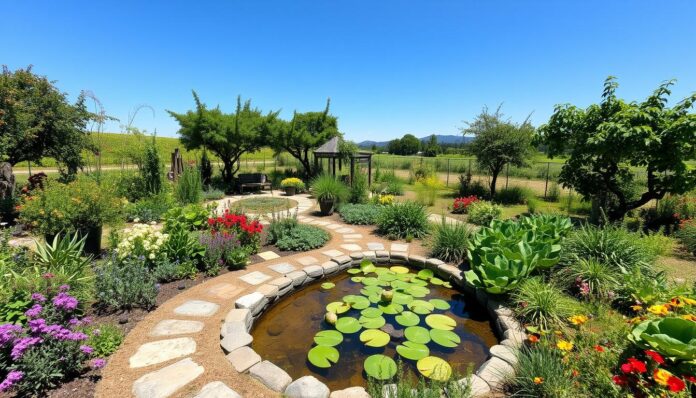The first time I visited a permaculture wellness garden, something magical happened. The colors, plant systems, and harmony changed how I saw sustainable living. What started as a simple plot became a living ecosystem that fed both body and soul.
Permaculture wellness gardens are more than a gardening method. They’re a way to create sustainable, healing spaces. By using natural principles and design, these gardens help us and the environment. Each plant and design element has many uses.
At its heart, permaculture wellness gardens offer a new way to live sustainably. They go beyond regular gardening, healing and connecting us with nature. With careful design and ecological rules, these gardens change our health and the planet.
Key Takeaways
- Permaculture wellness gardens integrate health and sustainability
- Gardens can provide therapeutic benefits beyond food production
- Natural design principles support both personal and environmental wellness
- Sustainable living starts with intentional garden design
- Wellness gardens create holistic ecosystems that nurture body and mind
Understanding Permaculture and Its Principles
Permaculture wellness gardens are a new way to garden that’s better for the planet. They create spaces that are good for both people and the environment. This approach makes gardens that are sustainable and work together with nature.
At its heart, permaculture is a way to design that follows nature. It has three main ethics for living sustainably:
- Earth Care: Protecting and regenerating natural systems
- People Care: Supporting human well-being and community
- Future Care: Ensuring resources for future generations
What is Permaculture?
Permaculture is more than gardening. It’s a way to design homes that are good for the planet. Ecological design focuses on making spaces that help nature thrive.
“Permaculture is a philosophy of working with, rather than against nature, of protracted and thoughtful observation rather than protracted and thoughtless labor.” – Bill Mollison
Key Principles of Permaculture
The permaculture method has 12 key principles for gardening:
- Observe and Interact
- Catch and Store Energy
- Obtain a Yield
- Apply Self-Regulation
- Use and Value Renewable Resources
- Produce No Waste
- Design from Patterns to Details
- Integrate Rather than Segregate
- Use Small and Slow Solutions
- Use and Value Diversity
- Use Edges and Value the Marginal
- Creatively Use and Respond to Change
By following these principles, permaculture gardens become living, breathing ecosystems. They support life, health, and the healing of the environment.
Benefits of Wellness Gardens
Wellness gardens in permaculture offer a new way to improve health. They mix nature therapy with green living. These gardens create a special place that helps our bodies, minds, and the planet.
Physical Health Advantages
Working in a wellness garden is great for our bodies. Gardening is like a workout, making us stronger and more flexible. Studies show that touching soil can make us feel better overall.
- Burns calories through active gardening movements
- Enhances muscle strength and endurance
- Provides access to fresh, organic produce
Mental Health Benefits
Nature therapy is a strong way to improve our minds. Being around soil bacteria can make us feel happier. It’s like a natural mood booster.
Being in nature and touching soil can make us feel better, like antidepressants, by boosting our immune system.
| Mental Health Benefit | Mechanism |
|---|---|
| Stress Reduction | Cortisol level decrease through gardening activities |
| Mood Enhancement | Serotonin release from soil bacteria interaction |
| Cognitive Stimulation | Problem-solving and creative engagement |
Environmental Impact
Wellness gardens in permaculture are good for the planet. They help animals, cut down on pollution, and make our ecosystems better.
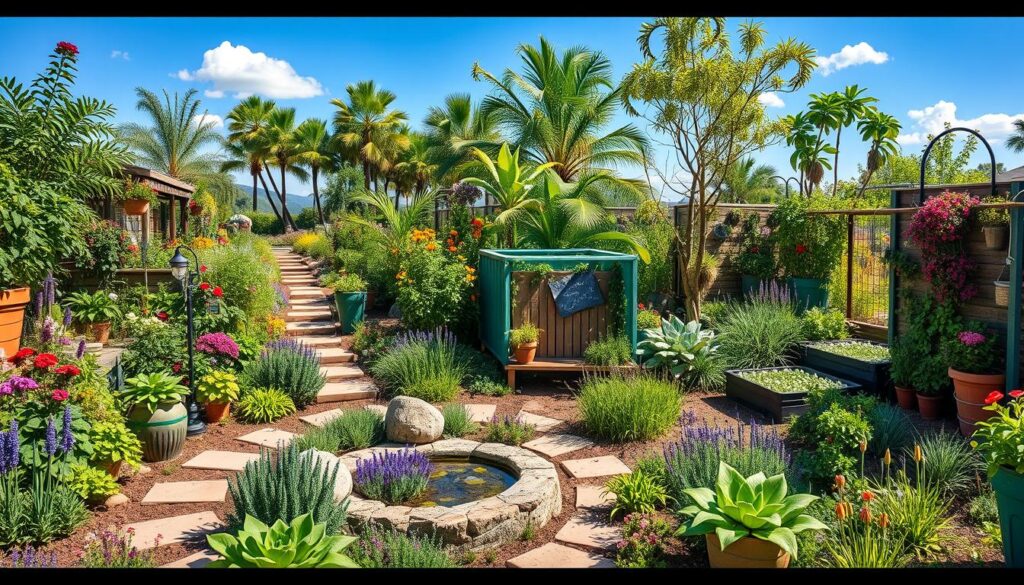
- Promotes local biodiversity
- Reduces chemical agricultural inputs
- Supports pollinator populations
Wellness gardens are a full package for health and the environment. They show us how to live better and take care of our planet.
Key Elements of a Wellness Garden
To make a wellness garden work, you need to plan well and know about regenerative agriculture. A good garden has key parts that help it grow strong and healthy.
Organic gardening is more than just growing plants. It’s about making a whole system that helps people and the planet.
Soil Health and Composition
Soil is the base of a great garden. Studies show that soil quality affects how well plants grow and how productive the garden is. To keep soil healthy, you should:
- Check soil pH and nutrient levels often
- Add organic compost
- Use fewer chemicals
- Rotate crops
“A healthy garden starts with living soil” – Permaculture Wisdom
Water Management Techniques
Using water wisely is key in regenerative agriculture. There are smart ways to save water and keep the garden healthy:
- Put up rain barrels to catch water
- Make swales to handle runoff
- Use drip irrigation
- Mulch to keep soil moist
Plant Selection and Diversity
Having different plants is vital in organic gardening. By choosing many plant types, gardeners can:
- Draw in good insects
- Make plants more resistant to pests
- Boost biodiversity
- Make the garden stronger
Remember, a wellness garden is a living, evolving system that needs constant watching and adjusting.
Designing Your Permaculture Wellness Garden
Starting a permaculture wellness garden needs careful planning and observing your landscape. It turns your outdoor area into a lively, productive space. This space helps both people and the environment.
Designing a permaculture wellness garden is more than just gardening. It’s about making a sustainable space that helps plants and people grow together.
Assessing Your Garden Space
First, do a detailed site assessment. Look at:
- Sunlight throughout the day
- Soil type and how water drains
- What’s already in your garden
- Your local weather
- How you’ll manage water
Creating Functional Zones
Permaculture gardens use zone planning to save energy and work better. This method groups areas by how often you use them and what plants need.
| Zone | Characteristics | Typical Elements |
|---|---|---|
| Zone 0 | Home/Living Area | Kitchen herbs, medicinal plants |
| Zone 1 | Most Frequented Area | Vegetable gardens, daily maintenance zones |
| Zone 2-3 | Less Frequent Access | Fruit trees, perennial crops |
Designing Paths and Access
Good path design is key in permaculture gardens. Make paths that:
- Lead to different garden areas easily
- Help manage water
- Keep plants safe
- Make your garden look nice
“Good design is the foundation of a thriving permaculture wellness garden.” – Ecological Design Expert
By following these ecological design tips, you’ll make a permaculture garden. It will support biodiversity, health, and the environment.
Incorporating Native Plants
Native plants are key in ecological design for sustainable living gardens. They have evolved naturally in specific areas. This makes them perfect for permaculture wellness gardens.
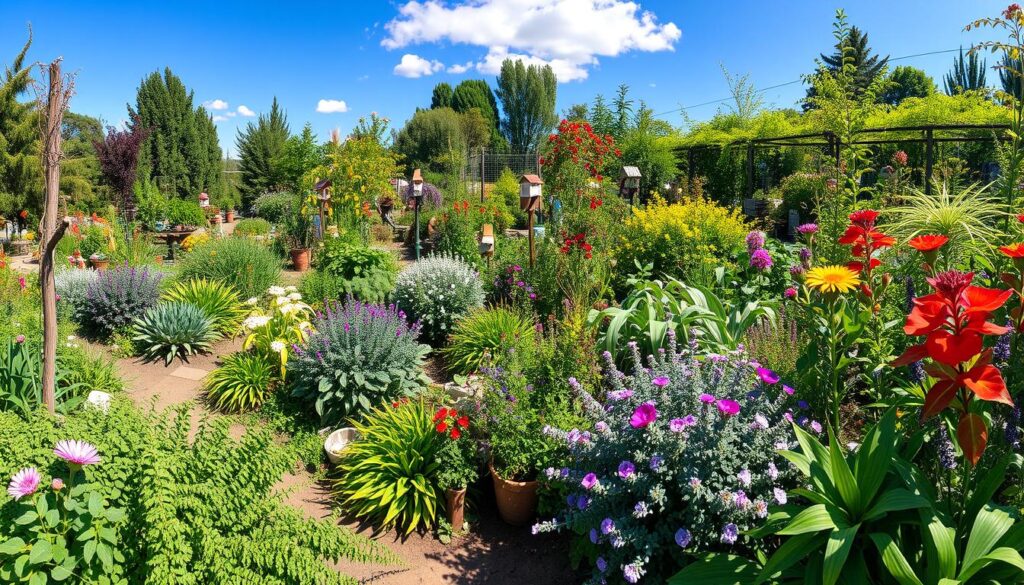
Native flora plays a crucial role in garden design. It turns gardens into powerful tools for ecosystem restoration. Local plants offer benefits that go beyond traditional gardening.
The Significance of Native Plant Species
Native plants have amazing ecological benefits:
- Exceptional drought resistance
- Minimal maintenance requirements
- Enhanced wildlife habitat support
- Natural pest resilience
- Superior soil conservation
Beneficial Native Plant Examples
Choosing the right native plants is important. It depends on the local ecosystem. Each region has its own native species that support sustainable living.
| Region | Native Plant | Key Benefits |
|---|---|---|
| Southwest | Agave | Water conservation, pollinator attraction |
| Northeast | Black-Eyed Susan | Soil stabilization, wildlife support |
| Pacific Northwest | Oregon Grape | Erosion control, medicinal properties |
“Native plants are not just decorative elements, but living participants in ecological design.” – Ecological Restoration Expert
Using native plants shows a deep commitment to creating lasting, self-sustaining gardens. These gardens work in harmony with their local environment.
Companion Planting Strategies
Organic gardening uses a powerful method called companion planting. It’s a key part of permaculture wellness gardens. This method links plants in ways that help each other, making the garden work better together.
Companion planting is more than just growing plants. It’s about how plants help each other grow. By picking the right plants to grow together, you can make your garden healthier and more productive.
Principles of Companion Planting
The main ideas of companion planting are:
- Using space wisely in your garden
- Keeping pests away naturally
- Improving soil health
- Making plants taste better
Effective Plant Pairings
Here are some great plant pairs:
| Plant Combination | Benefits |
|---|---|
| Tomatoes + Basil | Flavor enhancement, pest deterrence |
| Corn + Beans + Squash | Nitrogen fixing, shade protection |
| Onions + Carrots | Pest reduction, scent masking |
| Spinach + Strawberries | Mutual growth support |
“In nature, plants do not grow in isolation but in complex, interconnected communities.” – Permaculture Design Handbook
Using companion planting in permaculture gardens means less need for harmful chemicals. By knowing how plants work together, gardeners can make gardens that are strong and full of life. These gardens support many different plants and help them grow well.
Seasonal Planting and Maintenance
Organic gardening is all about knowing nature’s cycles. It’s about living sustainably and seeing how gardens change with the seasons. This creates a lively ecosystem for plants and gardeners alike.
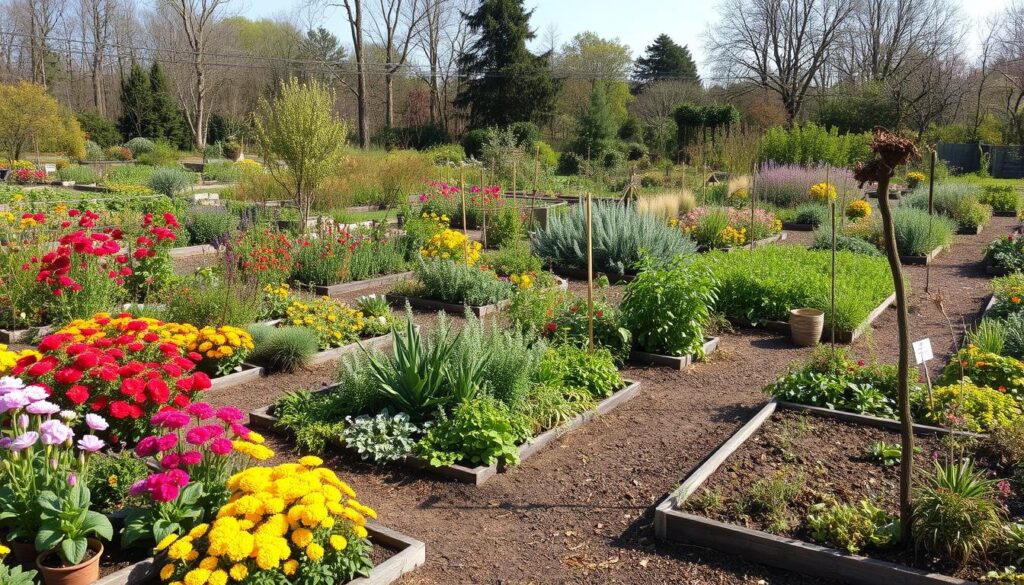
For a thriving permaculture garden, you need a good plan and careful upkeep all year. Each season offers special chances for sustainable gardening that fit with nature’s flow.
Understanding Planting Seasons
Permaculture gardening is all about planning with the seasons. Each plant has its best time to grow, so timing is key for a bountiful garden.
- Spring: Perfect for planting cool-season crops
- Summer: Ideal for heat-loving vegetables
- Fall: Excellent for root vegetables and winter preparations
- Winter: Time for planning and soil preparation
Seasonal Maintenance Tasks
Good garden care means adjusting to each season’s needs. Sustainable living is about working with nature, not against it.
| Season | Key Maintenance Tasks |
|---|---|
| Spring | Soil preparation, seed starting, pruning |
| Summer | Mulching, water conservation, pest management |
| Fall | Harvesting, composting, cover crop planting |
| Winter | Tool maintenance, garden planning, soil amendment |
Nature does not hurry, yet everything is accomplished. – Lao Tzu
By following nature’s rhythms, gardeners can build strong, fruitful spaces. These spaces not only grow food but also deepen our connection with nature.
Permaculture Techniques for Wellness
Regenerative agriculture brings powerful strategies for healthy, sustainable gardens. Organic gardening turns outdoor spaces into vibrant ecosystems. These spaces nurture both plants and people.
Permaculture offers new ways to manage gardens, beyond traditional methods. It focuses on building resilient, self-sustaining systems. These systems boost soil health and garden productivity.
Mulching: A Foundation for Soil Wellness
Mulching is key in regenerative agriculture, offering many benefits for garden health. It involves covering soil with organic materials. This helps:
- Keep soil moist
- Control weeds
- Manage soil temperature
- Improve soil structure
Composting: Transforming Waste into Nutrition
Organic gardening heavily relies on composting for nutrient-rich soil. It turns kitchen and garden waste into fertilizer. This process:
- Reduces landfill waste
- Makes free, high-quality fertilizer
- Boosts soil microbes
- Improves plant health
| Mulching Material | Benefits | Best Used For |
|---|---|---|
| Straw | Keeps moisture well | Vegetable gardens |
| Wood chips | Long-lasting protection | Perennial beds |
| Leaves | Adds organic matter quickly | Annual flower beds |
“In nature, there is no waste. Everything is recycled and becomes nutrients for new life.” – Bill Mollison, Permaculture Pioneer
By using these permaculture techniques, gardeners can make living ecosystems. These ecosystems support both plant and human wellness. They turn gardens into sustainable, productive spaces.
Wildlife and Pollinator Support
Ecological design in sustainable living is more than just making gardens look good. It’s about creating lively ecosystems that help local wildlife and pollinators. Permaculture wellness gardens are key habitats that boost biodiversity and improve environmental health.
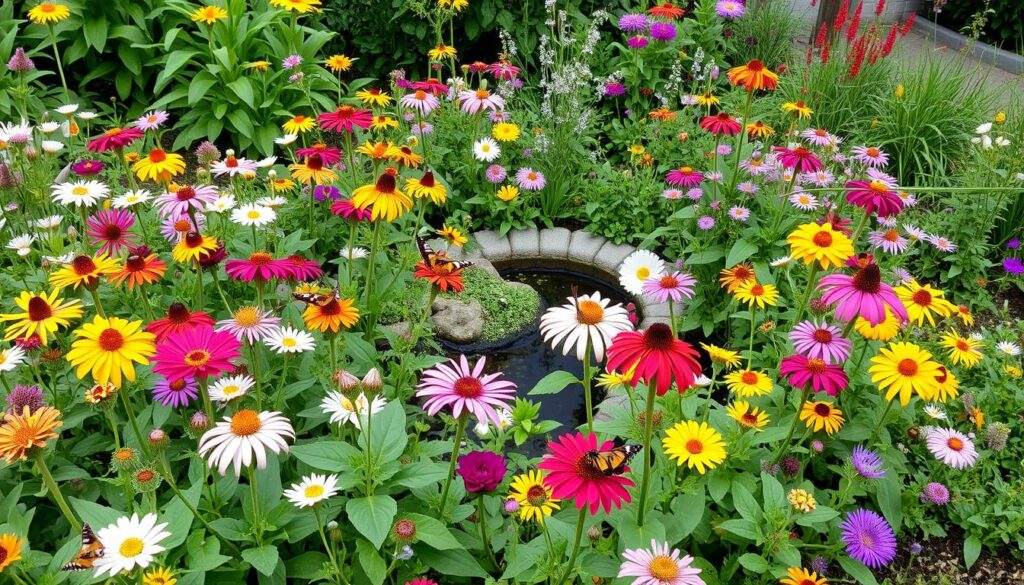
The Crucial Role of Pollinators
Pollinators are the hidden heroes of our ecosystems. They are vital for food production and keeping ecosystems healthy. Studies reveal that bees pollinate about 80% of crops, adding €260 billion to global farming each year.
- Honeybees can forage up to 3 kilometers from their nests
- Bumblebees typically forage within 100-800 meters
- Pollinator gardens reduce reliance on chemical pesticides
Creating Wildlife Habitats
Practices like sustainable living can turn gardens into wildlife sanctuaries. By using native plants and herbs rich in nectar, gardeners help pollinators and make ecosystems stronger.
A garden is a complex ecosystem where every plant and creature plays a vital interconnected role.
Here are some ways to support wildlife:
- Plant diverse native species
- Provide water sources
- Create sheltered nesting areas
- Avoid synthetic pesticides
By following ecological design, gardeners can make spaces that help wildlife. They also get to enjoy the benefits of a lively, healthy ecosystem.
Gardening as a Therapeutic Practice
Nature therapy through gardening is a deep way to find holistic health. Turning outdoor areas into healing spots can bring big benefits for those looking for wellness.
Gardening is a strong way to help with emotional healing and growth. Studies show it’s great for connecting with nature and feeling better.
The Emotional Benefits of Gardening
Working with plants and soil can really help your mind. Studies show it’s good for stress, anxiety, and mood issues:
- 100% of participants report experiencing mental health benefits
- Over 50% find significant emotional recovery through gardening
- 70% experience psychological relief from nature interactions
Therapeutic Techniques in Gardening
“Gardening is cheaper than therapy, and you get tomatoes” – Unknown
Nature therapy can be tailored to fit different needs. New ways include:
- Starting with short 5-minute outdoor sessions
- Using ergonomic gardening tools
- Incorporating mindful garden activities
| Therapeutic Gardening Approach | Mental Health Impact | Accessibility |
|---|---|---|
| Indoor Gardening | Stress Reduction | High (40% engagement) |
| Group Garden Sessions | Social Connection | Medium |
| Permaculture Zones | Sustained Engagement | High |
Gardening is more than a hobby—it’s a journey to holistic health and personal renewal.
Sustainable Practices in Wellness Gardens
Permaculture wellness gardens are a key part of sustainable living. They use ecological design to change how we garden. These gardens do more than grow plants; they create systems that use resources wisely and waste less.
At the heart of permaculture gardens are sustainable practices. Gardeners use new methods to make spaces that are good for the planet and for people.
Reducing Waste Through Recycling
Permaculture gardens see waste as something valuable. They use recycling to:
- Compost kitchen scraps
- Use organic materials in new ways
- Make systems that manage waste well
By recycling, these gardens turn waste into soil that’s full of nutrients. This follows the idea of zero waste in ecological design.
Water Conservation Strategies
Managing water is key in sustainable gardening. Good methods include:
- Catching rainwater
- Using drip irrigation
- Mulching to keep soil moist
“In permaculture, every drop of water is a resource to be cherished and strategically used.” – Permaculture Design Principle
| Water Conservation Method | Water Savings Potential | Implementation Difficulty |
|---|---|---|
| Rain Barrel Collection | Up to 40% reduction | Low |
| Drip Irrigation | 50-60% reduction | Medium |
| Swale Systems | 70% water retention | High |
By using these practices, gardeners can make wellness gardens. These gardens help people stay healthy and also protect the environment.
Engaging the Community
Community gardening is a powerful way to live sustainably. It turns cities into lively, shared green spaces. These gardens do more than grow food; they build connections, share knowledge, and improve health in neighborhoods.
Community gardens have a big impact. They change cities for the better, like in Detroit. There, urban farming has grown a lot.
Benefits of Community Gardening
- Enhances local food security
- Builds social connections
- Promotes sustainable living practices
- Provides educational opportunities
Detroit’s journey with urban farming shows the power of community gardens. The city went from 80 farms in 2000 to over 1,500 today. These farms produce about 400,000 pounds of fresh food each year. This growth shows how gardening together can change a city.
Collaborative Garden Projects
| Project Type | Community Impact | Environmental Benefit |
|---|---|---|
| Community Composting | Reduces waste | Generates nutrient-rich soil |
| Shared Seed Libraries | Preserves biodiversity | Promotes local plant varieties |
| Educational Workshops | Builds community knowledge | Supports holistic health |
“Community gardens are living classrooms that nourish both body and soul.”
Getting involved in community gardening is very rewarding. Research shows that 64% of people who garden feel ready to tackle environmental issues. And 92% start doing more to help the planet.
Education and Workshops
Permaculture wellness gardens are great for learning about sustainable living. They turn learning spaces into places where knowledge and plants grow together.
Learning about permaculture wellness gardens is more than just gardening. It’s about understanding the world and how we can live better.
Teaching Permaculture Principles
Teaching permaculture needs to be fun and hands-on. Important teaching methods include:
- Hands-on practical demonstrations
- Interactive workshop experiences
- Collaborative learning environments
- Real-world sustainable living applications
Organizing Garden Workshops
Good workshops mix theory with practice. Here are key things to think about when planning:
| Workshop Element | Key Considerations |
|---|---|
| Duration | 2-4 hours recommended |
| Participant Capacity | 12-16 participants |
| Outdoor Learning | 50% hands-on experience |
| Focus Areas | Composting, plant diversity, ecosystem design |
“Gardens are not just spaces for growing plants, but environments for cultivating knowledge and community.” – Permaculture Educator
People who take part in permaculture workshops often say it changed their lives. These learning experiences encourage us to live more sustainably and understand the world better.
Future Trends in Permaculture Wellness Gardens
The world of ecological design is changing fast, bringing new ideas to sustainable living. Permaculture wellness gardens are now using advanced technology and caring for the environment in new ways.
Innovations in Sustainable Gardening
Modern permaculture is using the latest tech to make gardens better and protect the environment. Smart sensors and digital tools are changing how gardeners work with their ecosystems.
- Advanced soil health tracking technologies
- Precision irrigation systems
- AI-powered garden planning tools
- Climate-adaptive plant selection algorithms
The Role of Technology in Gardening
Digital tools are turning gardening into a modern, connected activity. Permaculture gardening now uses advanced technology to help gardeners use resources better.
| Technology | Function | Impact |
|---|---|---|
| Drone Mapping | Garden Space Analysis | 50% Improved Planning |
| Smart Sensors | Soil Moisture Tracking | 40% Water Conservation |
| Mobile Apps | Crop Management | 30% Increased Yield |
As we focus more on living sustainably, permaculture wellness gardens are becoming hubs of green innovation. They mix new tech with nature, showing us how to live in harmony with the environment.
Getting Started with Your Wellness Garden
Starting your permaculture wellness garden is more than a hobby. It’s a lifestyle change. Brad Krass’s New Flower farm shows how permaculture works in different places. It encourages gardeners to create their own sustainable spaces.
Begin by designing your garden to be efficient. Aim for a layout that reduces walking paths and boosts ecosystem health.
To succeed in your garden, observe and plan carefully. First, check your space and local weather. Learn permaculture techniques to make a garden that grows food and supports your health. Use diverse plants like Tulsi, which grows well in many climates. Also, focus on soil health with composting and microbial solutions.
Initial Steps to Take
Start with small parts of your garden. Use rainwater catchment systems and companion planting to boost your garden’s output. Brad’s composting method improves soil and supports microbes. Up to 80% of soil health comes from microbes, so this is key.
Resources for Further Learning
Grow your knowledge with local workshops, community gardens, and permaculture resources. Gardening is good for your body and mind. It lowers stress and boosts happiness. Your garden is a journey into sustainable living.

